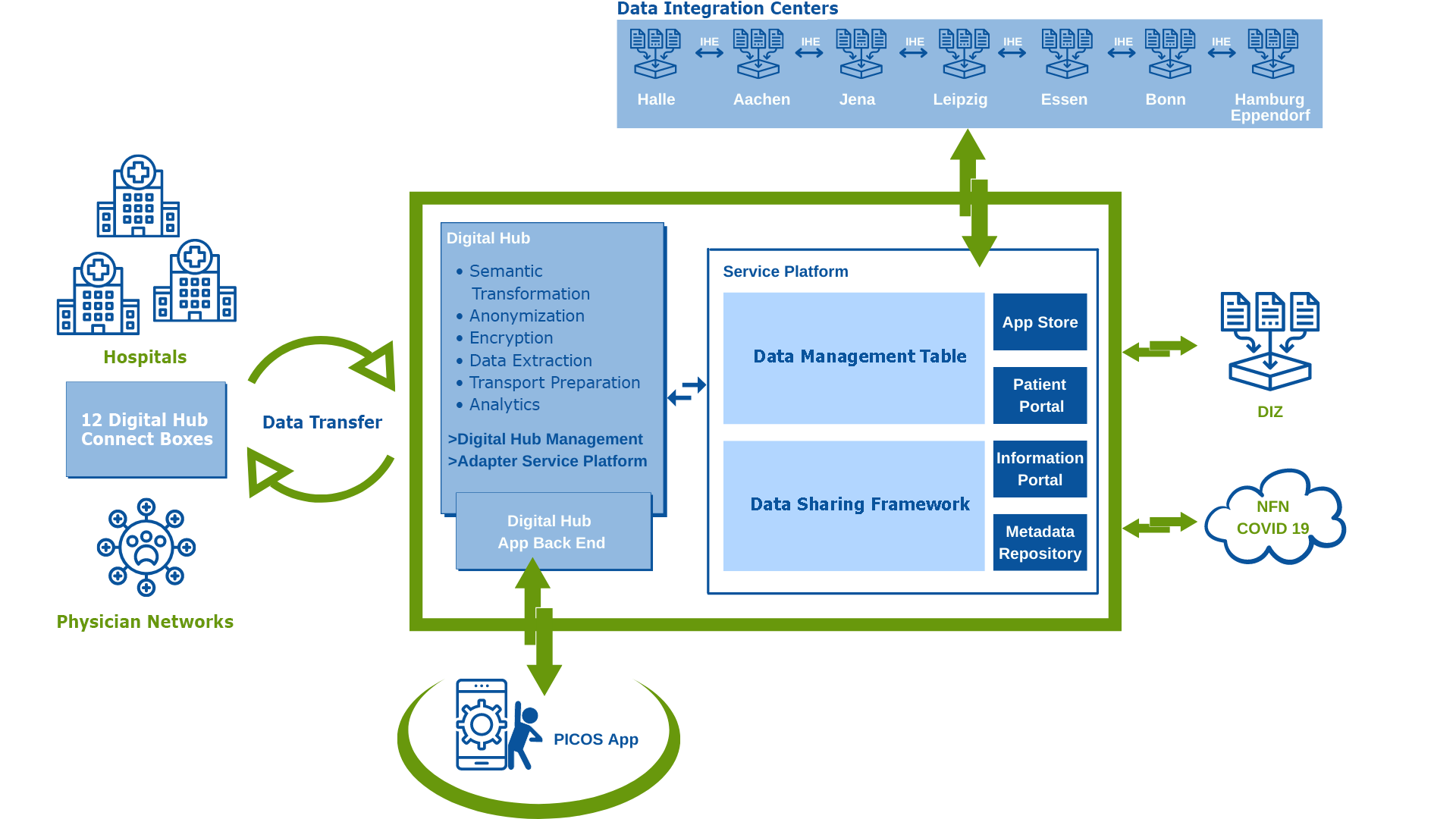
Digital Hub
Enabling cross-sector data exchange between regional care providers
Every day, clinics and medical practices generate millions of patient data points that hold enormous potential for the healthcare of tomorrow. However, most patient data from medical institutions still exists in unused, heterogeneous formats. The Medical Informatics Initiative (MII) has already laid the foundations for a digital infrastructure to make patient data from routine care usable for health research, particularly in university medicine. In this context, routine care data are digitally networked nationwide via Data Integration Centers and made available for medical research purposes. The Data Integration Centers provide the technical and organizational conditions for secure, privacy-compliant access to high-quality routine healthcare data. At each site, medical data are consolidated, converted into a uniform format, and made available for research and analysis projects. In addition, the Data Integration Centers are networked nationwide, enabling cross-site projects. The results can flow directly back into care, enabling faster and more effective treatment and therapy options in the future.

DISTANCE architecture for networking between non-university and university structures
with the Digital Hub and the existing structures of the SMITH Consortium. (Source: UK RWTH Aachen)
Improving research and healthcare through the networking of regional care data
DISTANCE transferred the MII’s technical concept to regional hospitals and outpatient physician networks. The project built on IT solutions previously developed within the SMITH Consortium. Its aim was to optimize medical care through cross-sector data exchange and the integration of medical data into the MII core data set. The core data set defines the data sets, IT and terminology standards for all MII sites according to which inpatient data must be available in the Data Integration Centers. The long-term goal is to increase the availability of real-world care data, simplify access to the data, and accelerate the transfer of research results to intersectoral care.
For the first time, longitudinal data from former intensive care patients were collected using the PICOS App. Medically highly relevant data were repeatedly recorded from the same individuals over an extended period. In addition, artificial intelligence (AI) was used to better predict disease progression after intensive care treatment.
Core element in DISTANCE: the Digital Hub
The Digital Hub served as the basis for cross-sector, interoperable data exchange between university institutions, participating primary and secondary care hospitals, and office-based physicians. The Hub performed the same functions as a university Data Integration Center but was explicitly used to network and exchange data among non-university care providers. For this purpose, data from routine care were centrally collected, anonymized, and made usable nationwide. All participating regional healthcare providers were connected via so-called Hub Connect Boxes, which are operated locally at the respective sites. Since 2025, the Digital Hub has been continued with the help of a sustainability plan to connect regional healthcare providers to the MII network beyond the funding period.
The added value of the DISTANCE Hub approach was assessed
Building and operating the infrastructure involves immense effort. Therefore, within the DISTANCE project, not only the feasibility but also the added value of the DISTANCE Hub approach for intensive care, medical procedures, and research was evaluated. To establish MII structures across sectors in the future, the efforts required from the rollout partners were estimated. A long-term national rollout will only be possible if the additional effort for this process, as well as all operating costs, can be appropriately reimbursed.
As a DISTANCE project partner, ZTG Zentrum für Telematik und Telemedizin GmbH conducted a health economic evaluation. On the one hand, this evaluation determined the costs of DISTANCE in order to model the costs of a national roll-out of the developed infrastructure. Secondly, the costs were compared with the expected benefits.
The Digital Hub DISTANCE was funded by the Federal Ministry of Research, Technology, and Space (BMFTR) with €10.9 million from June 1, 2021, to September 30, 2025. From October 1, 2025, the project was continued as DISTANCE:PRO.

